Thomond -
Thomond no.2
Thomond no.2
After making
Thomond no.1,
his first, non-commercial Thomond for his own use,
James A. Jones
did not try to make a business out of producing cars.
Such a business would be very hard to break into for such a small team.
Alan Hogan
said:
"Hand-made is for a Rolls-Royce".
John Wilkinson
said:
"That was no time to succeed in selling 'one-off' car projects
and, I fear, however good the car, it was doomed from the start".
The first car, crude as it was, had impressed though, and impressed in particular
Dick Humphreys,
who saw the car in 1926.
Once he was established in his new tyre business,
Dick asked Jones to build him a car to a personal specification.
In Dick's words in his 1963 article:
"Always courteous and helpful, he agreed to what must have seemed a rather
cool proposal".
So, in 1928, over 3 years after the construction of Jones' car,
a second 'Thomond' was planned.
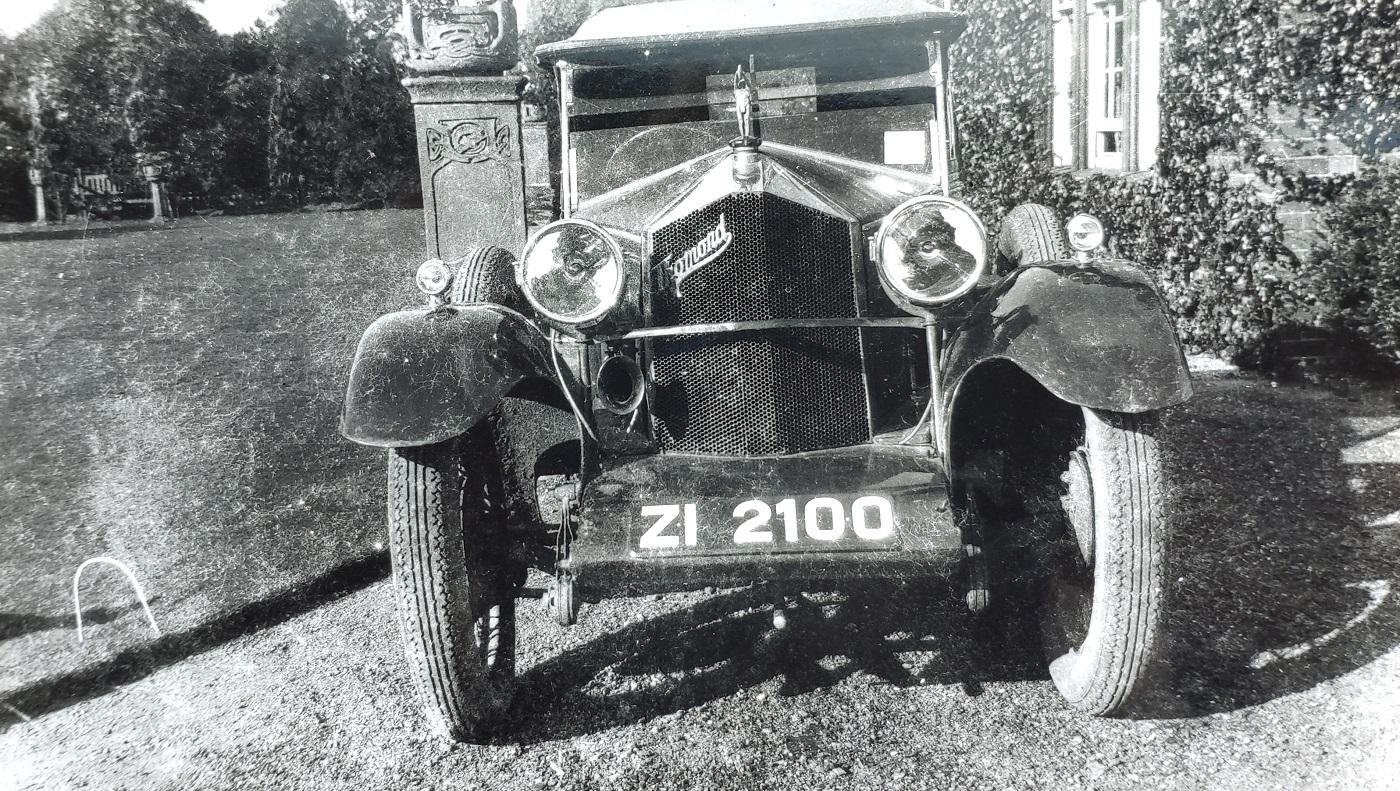
Thomond no.2 before modifications, at
36 Ailesbury Rd.
See
larger
and
full size.
Dick's Rhode
When
Dick Humphreys
saw
Thomond no.1
on the 1926 24 Hours Trial,
he was driving a
Rhode.
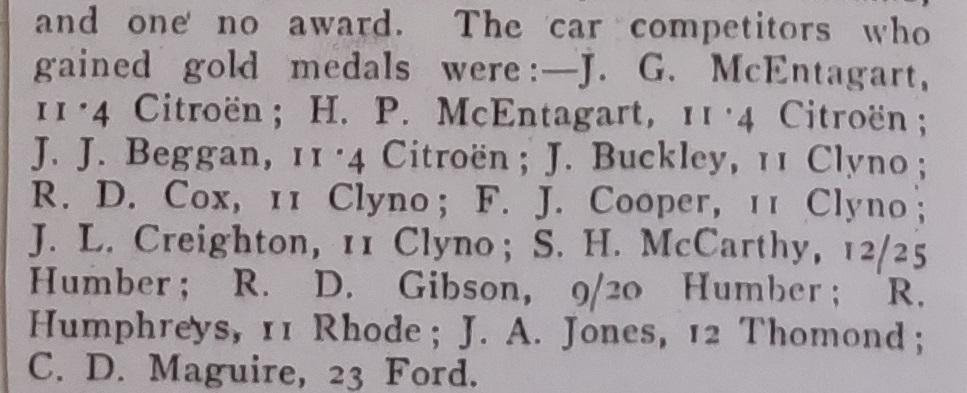
Humphreys (Rhode)
and Jones (Thomond no.1) in the 1926 24 Hours trial.
From
The Motor News,
19 June 1926.

Dick and
Alice Cashel
in the Rhode, at
Cashel House in
1926.
The families knew each other.
Later, in 1929, Dick married Alice's niece.
See larger
and full size.
See other scan.
-
I had a note that
Eibhlín
remembered the Rhode as green, with
gears written in chalk on the dashboard.
- I wonder is this confusion with another car.
She was born in 1911 and was only a teenager around 1926.
Did she know the Humphreys family then?
Her
mother
was in
Cumann na mBan
but I am not aware that the families met.
She married Dick's brother in 1934.
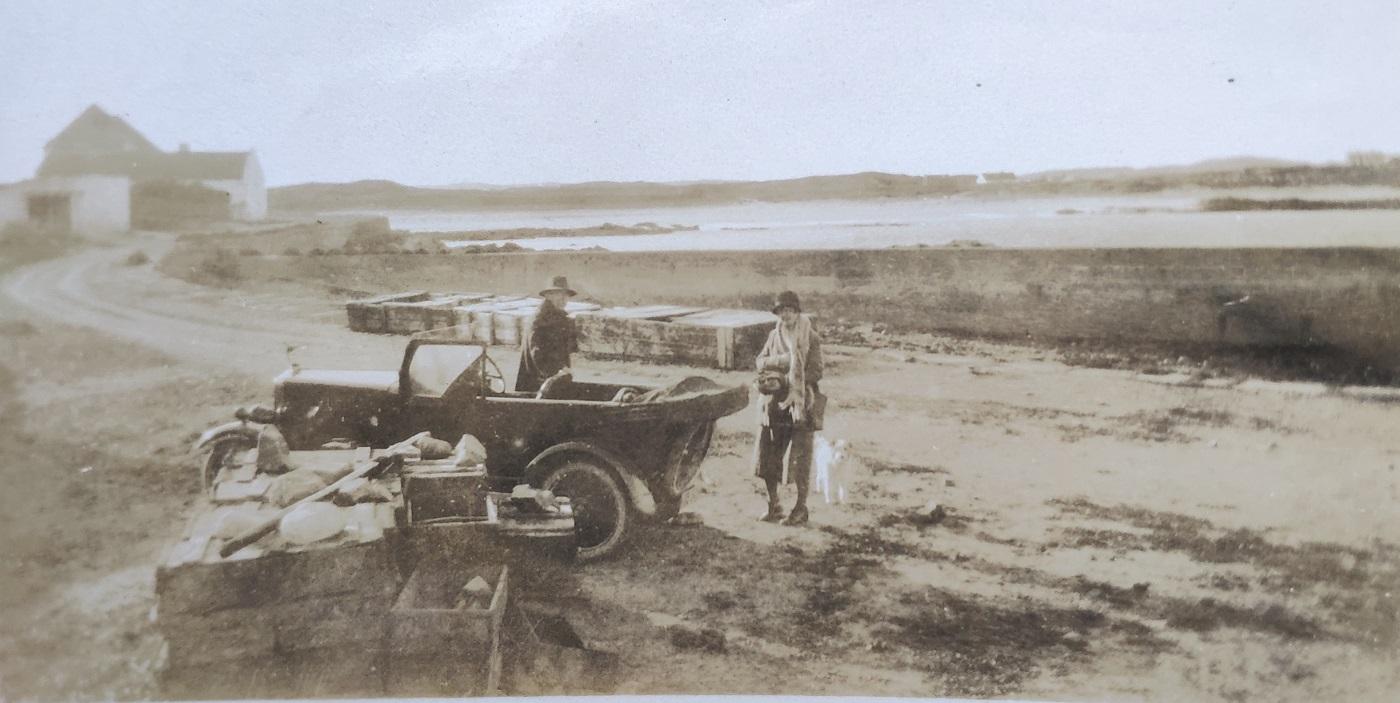
Dick's Rhode, Connemara, 1926.
Looks like Dick on left
and
Alice Cashel on right.
See
larger
and
full size.
See
other scan.
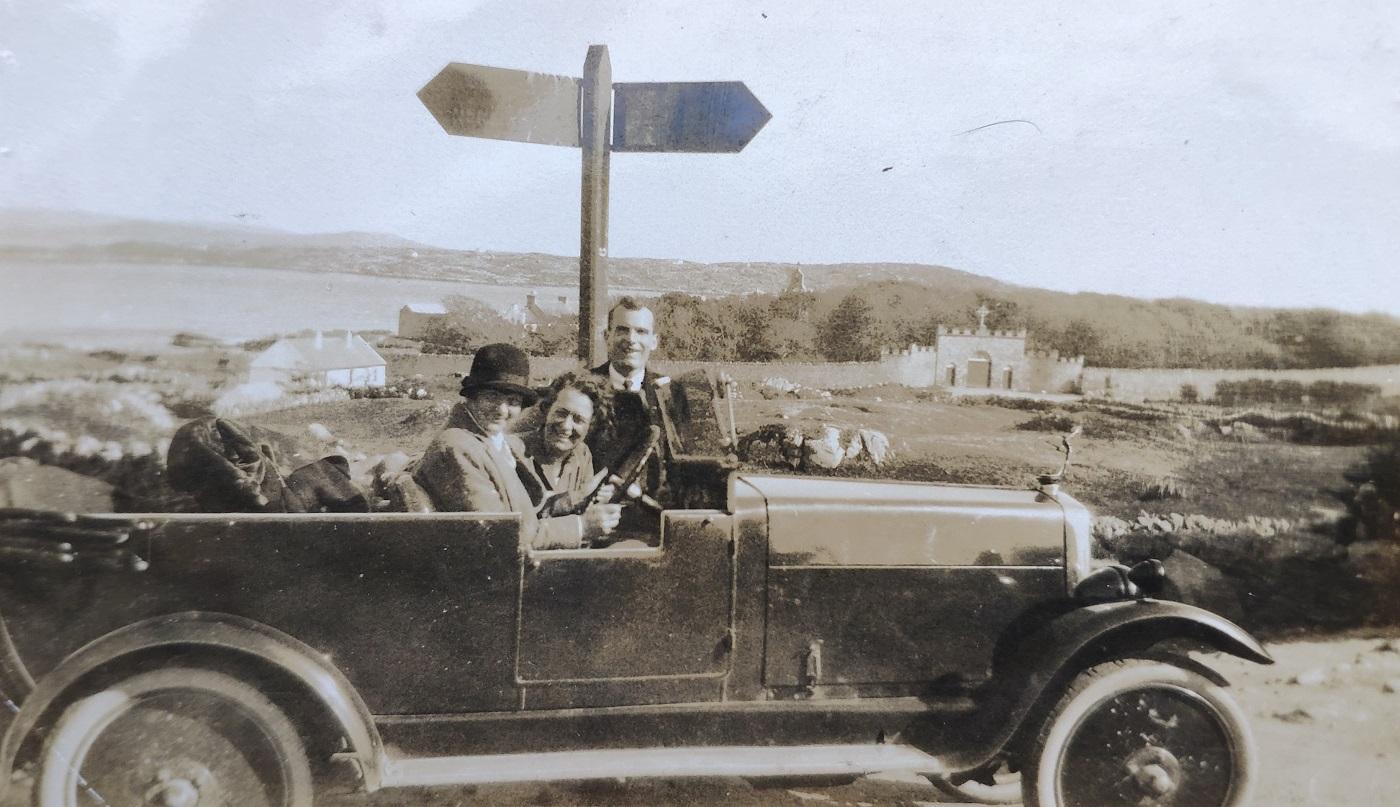
Left to Right:
Alice Cashel,
unknown,
Steen O'Mara.
In the Rhode,
Roundstone Harbour, Connemara, 1926.
See larger
and full size.
See other scan.
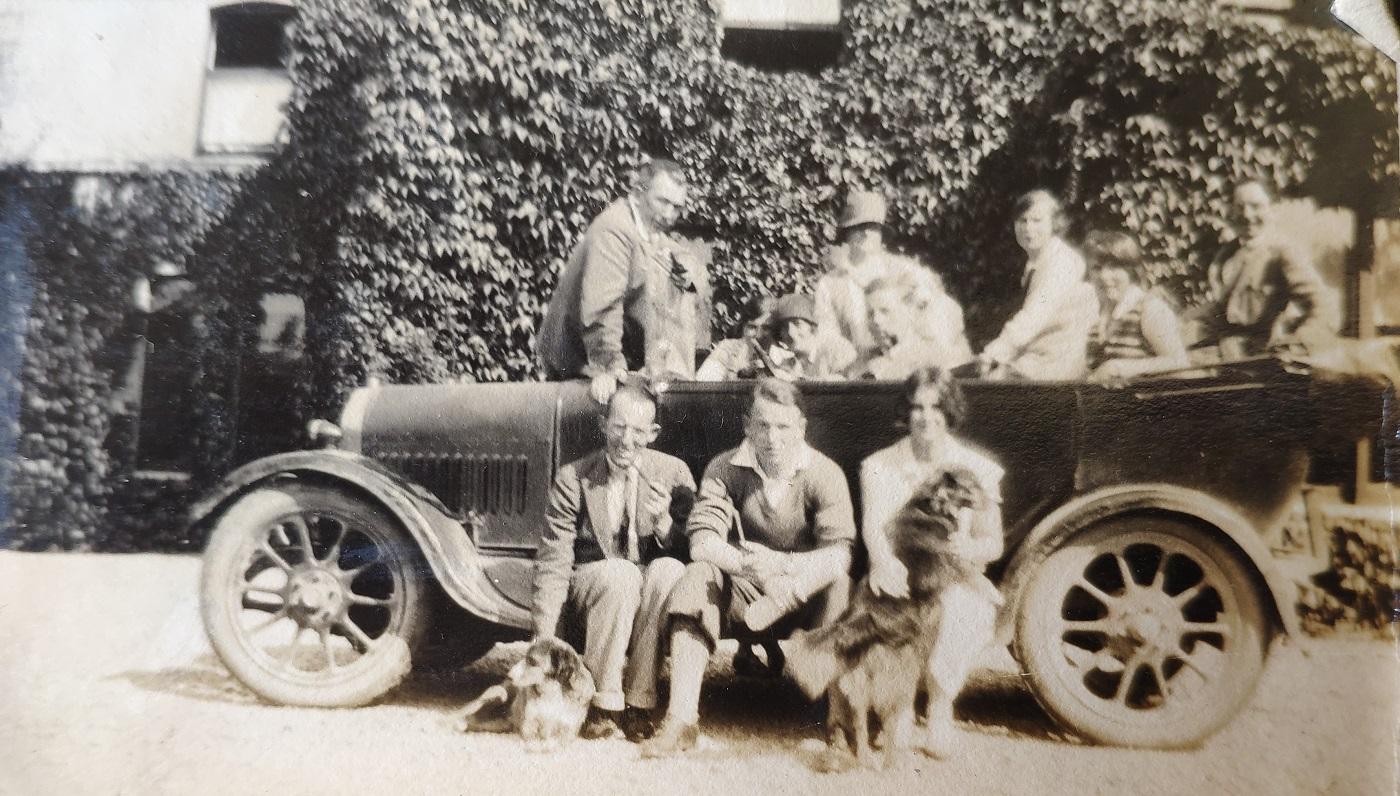
An unknown car at
Cashel House in
1928.
Probably a later Bullnose Morris.
See larger
and full size.
See other copy.
See other copy.
Building the Thomond
So, in 1928, Dick planned the building of his own Thomond car
at Jones' garage.
Firstly, Dick went to the 1928
Olympia Motor Show in London.
This was held between 11 Oct and 20 Oct 1928.
It was a big show,
with 95 car firms
from 7 countries.
The Motor News reported it as "a sensible show",
getting down to the business of selling practical cars.
Trends were towards comfort, noise control, smoothness
and efficiency.
Many cars were
phasing out running boards and chassis. The main exhibits included the
tremendously popular Morris Minor,
the tiny Baby Austin, and the new
Lancia Lambda
and Dunlop Fort tyre. Every car was rear wheel drive,
except for the brand new front wheel drive
Alvis.
One company on show was Barker and Co., whose exhibits included
collapsible occasional seats. Dick was impressed with this idea, and
adopted a Barker seat for use in his own novel seating layout.
Returning with armloads of motor accessory books, Dick spent
a happy few months outlining and sketching his dream car.
Early in 1929, the mechanical parts were ordered from England.
Although the car had a high Irish content, especially as regards
such things as bodywork and upholstery, most of its mechanicals
were English, from companies such as
Meadows,
Ford
and
Rubery Owen.
It was easy to import parts in those days before the
Economic War (1932).
Tommy O'Brien,
who worked for Dick at 36 Pearse St,
remembered Dick ordering the parts.
All the documentation for the parts came in to Pearse Street in 1928-1929,
invoiced to Dick, delivered to Jones.
Dick did all the drawings for Jones too.
Work on the car continued throughout 1929, and Jones' chief mechanic
Benny Parsons
used all his skill and expertise in transforming Dick's complex plans
into a well-finished motor car.
Chassis work would have involved
drilling holes to take various fittings, with bolt-on brackets
for mechanical components and bodywork.
Thomond no.2 was completed in the late summer of 1929, well in time for
Dick's marriage to Eithne O'Mara
on 24 September 1929.
1963 article
says he had the Thomond when Eithne was still his fiancée.
Reactions:
-
Tommy O'Brien,
recalled the first day Dick brought the Thomond out,
and showed it to Tommy
outside Pearse St (1929).
Tommy never rode in it, or even sat in it.
He was not very impressed with the whole plan.
He thought it was a mistake building a car
rather than buying a car.
He thought more of Dick's drawings
than of the car itself.
-
Dick's sister Sighle
was more impressed.
She
recalled the Thomond as very comfortable.
She said it had a feeling of being very compact.
She couldn't see anything wrong with it, "since he made it".
Dick married Eithne in Sept 1929.
He did not however take the Thomond on honeymoon.
He took a reliable Fiat
on their Continental tour in late 1929.
Why?
Eithne thought it might have been family pressure.
(Maybe from her father James O'Mara.)


Dick's breakdown of costs in
1963 article.
See
full article.
Specification
Body:
-
2 door, 3 seater touring coupe.
- One small seat in at back.
- Plywood and fabric Weymann-type body.
- Small rectangular rear window.
No rear side windows in the hood.
- Chassis probably from Rubery Owen.
X-braced channel-steel frame of very heavy gauge metal.
- Just below the boot was the fuel tank, where the fuel gauge was located
outside on the filler cap. Fuel consumption was 26 to 30 mpg.
Colour:
- Its
colours are listed in [Motor Reg]
as tan and red.
- The main colour appears to be red.
Dick painted colours on a photograph. He painted the body dark red.
- Dick's wife Eithne
agreed it was red and tan.
- Tommy O'Brien
agreed it was red and tan.
He remembered a 'dark maroony' red.
Engine:
- Meadows
4ED engine.
[Motor Reg] says engine built 1928.
- Meadows were the favourite supplier of engines to quite a lot of small
companies in those days, because of their reliability. They were a standardised
off-the-shelf reliable component, purchased by the smaller manufacturers,
and also by people building their own 'specials' and one-offs.
-
4 cylinders in line. 2 overhead valves per cylinder.
2 Solex carburettors.
- Bore 69 mm (2.72 in) x stroke 100 mm (3.94 in).
- Capacity 1496 cc.
Compression ratio 5.6:1.
- RAC horsepower
(tax rating)
of 12 horse power.
- Brake horsepower
of 48 bhp, probably at 4500 rpm.
-
Thomond letterhead,
describes it as "12-48 H.P."
1963 article says 50 bhp.
- Water cooled. No fan.
- C.A.V. electrical equipment.
Coil ignition with 12 volt C.A.V. dynamo.
Also had starting handle.
- 4 speed gearbox.
-
Distinctive V radiator, made by Fletcher and Phillipson of 10 Lower Baggot St, Dublin.
Wheels and brakes:
- After the rather ugly artillery wheels of Thomond no.1,
the design of Humphreys featured lighter, better performance
Dunlop wire wheels with tangential spokes.
- 5 x 19 in. Dunlop tyres.
(Even though Dick was selling O'Mara tyres,
he fitted Dunlops to both of his Thomonds.)
- The 2 spare wheels were originally held on either side of the car,
in dips between the front mudguard and the running board.
Later they were removed and one wheel mounted on the boot.
- Wire-operated 4 wheel brakes.
60 / 40 braking effect ratio front and rear.
- 1963 article says it weighed 21.25 cwts (1080 kg).
Though [Motor Reg]
says it weighed 19 cwts (965 kg).
49 / 51 weight distribution front and rear.
Logo:
- 'Thomond' written in flowing writing on radiator at front,
angled on left hand side.
Also
'Thomond' written in flowing writing on boot lid,
angled on left hand side.
- Later modification moved 'Thomond' at the front to position
horizontal at centre.
- Mascot was a version of the popular
"Spirit of Triumph"
mascot.
The original was
designed by Francois Bazin
for
Isotta Fraschini cars
in apparently 1919.
It was possible to purchase copies of it.
- Later modification removed the mascot.
Registration:
- Registered by Dick Humphreys as ZI 2100
[Motor Reg].
This is a Dublin city registration.
- Dublin City is ZI 1 to ZI 9999 (Mar 1927 to May 1933).
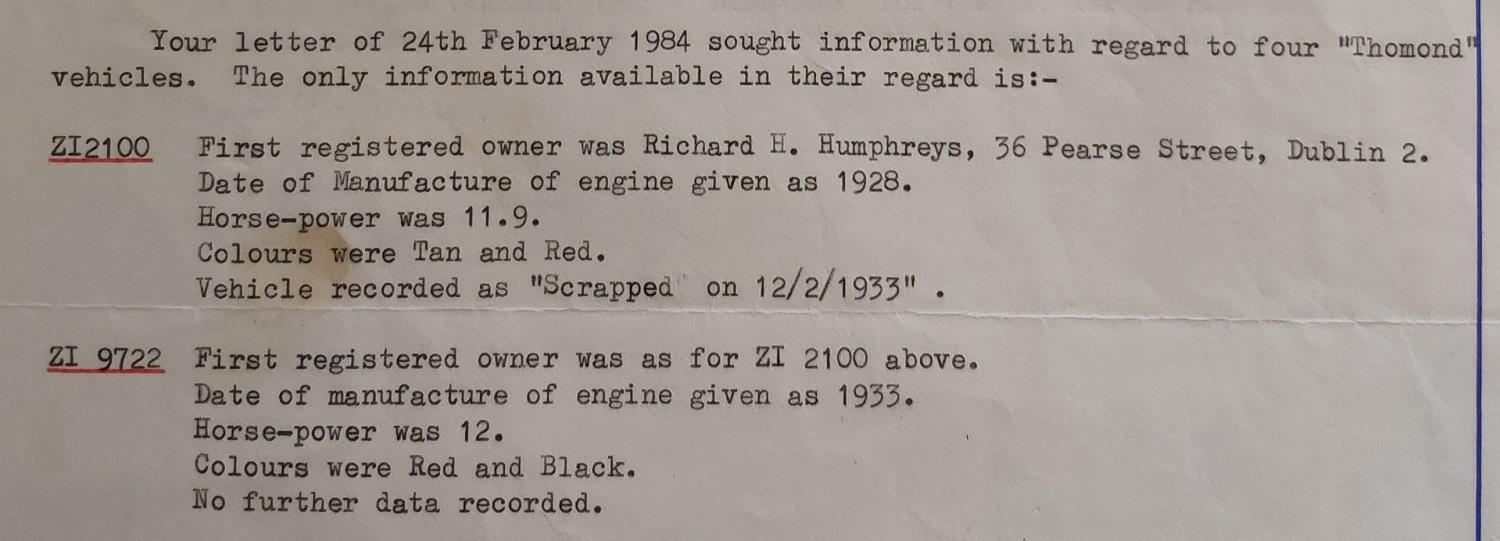
An abstract of the
[Motor Reg]
records for Thomonds no.2 and no.4.
There is an error in the abstract for Thomond no.2. The record actually says scrapped 17 Feb 1933.
See
full size.
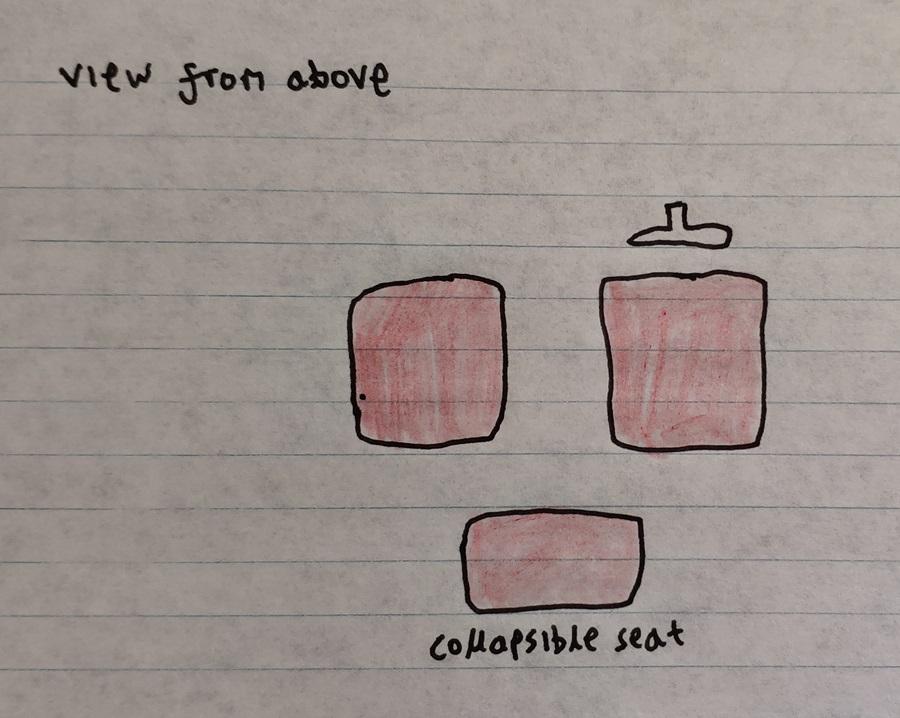
The seating arrangement is described by
Brian Hogan
as 'cloverleaf'.
2 normal size front seats,
with the small collapsible Barker
seat semi-staggered centrally behind them.
The upholstery was a rather bright red leather.
A staggered seat idea was later
employed by Dick's son Richard
in his 1970s 'Thomond' design.
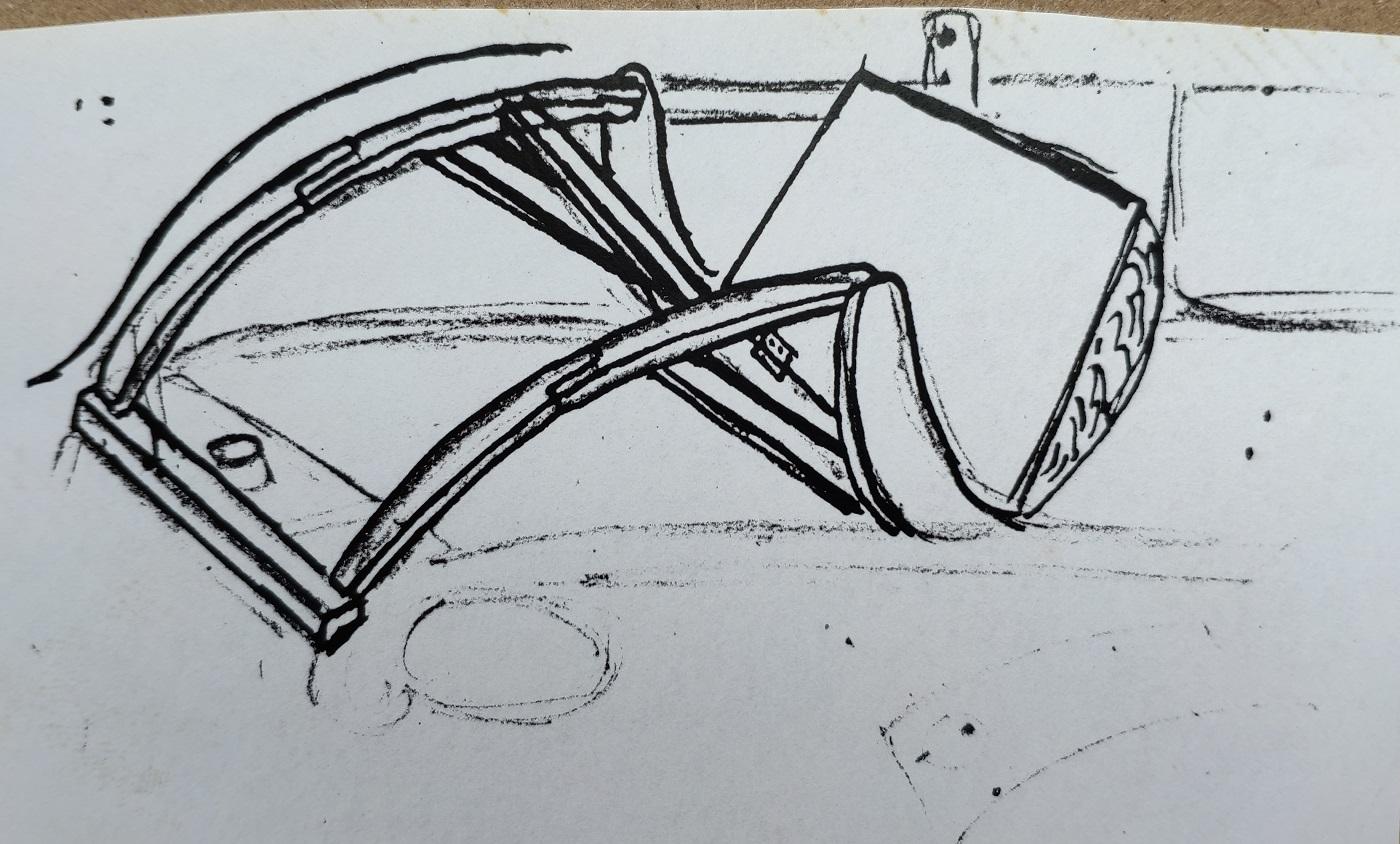
Sketch by Dick showing how the rear seat folded to give luggage space.
Note hinge. Note fuel tank location.
See larger
and full size.

Fletcher and Phillipson, 10 Lower Baggot St, who made the V radiator.
From p.1347
of [Thom's, 1928].
Street numbers are the same today.
See modern
street view.
Performance
Dick took delivery of his Thomond in the late summer of 1929.
He recorded some very high speeds on his regular trips down to
Cashel House, Connemara, Co.Galway,
country house of
his fiancée Eithne O'Mara's family.
In his
1963 article
he says:
"Never having owned such a powerful car before I was thrilled to the core
by its performance on the road, and many a time I would leave Dublin
at 5 or 6 am to visit my fiancée who lived down in Connemara in those days,
breakfasting at Cashel (near Roundstone) between 9.30 and 10 am.
The 20 mile stretch between Kilbeggan and Athlone proved a very useful test
and I usually covered this section in about 20 minutes,
the best time was under 18 minutes on one particularly traffic-free day".
Dublin to Cashel is about 176 miles, so he was averaging over 40 mph for the
entire trip, including the slow back roads of Connemara.
The 20 miles in 18 minutes is an average of 67 mph.
This was a very fast machine for its time.
Traffic then rarely passed 40 mph.
1963 article
says that the best running speed was 60-65 mph, and that the
Thomond was once timed at just under 80 mph on the
Phoenix Park Grand Prix circuit.
Dick also modified his car so that the thrill of its speed
could be enhanced by folding down the windscreen.
1963 article
says:
"An attractive feature was that the windscreen could be laid flat,
giving an aeroplane-like thrill which one misses completely nowadays".

The Kilbeggan to Athlone stretch on a
map
of 1900-1906.
It would have been little different in 1929.
Dick's 67 mph average would have included going straight through the town of Moate!
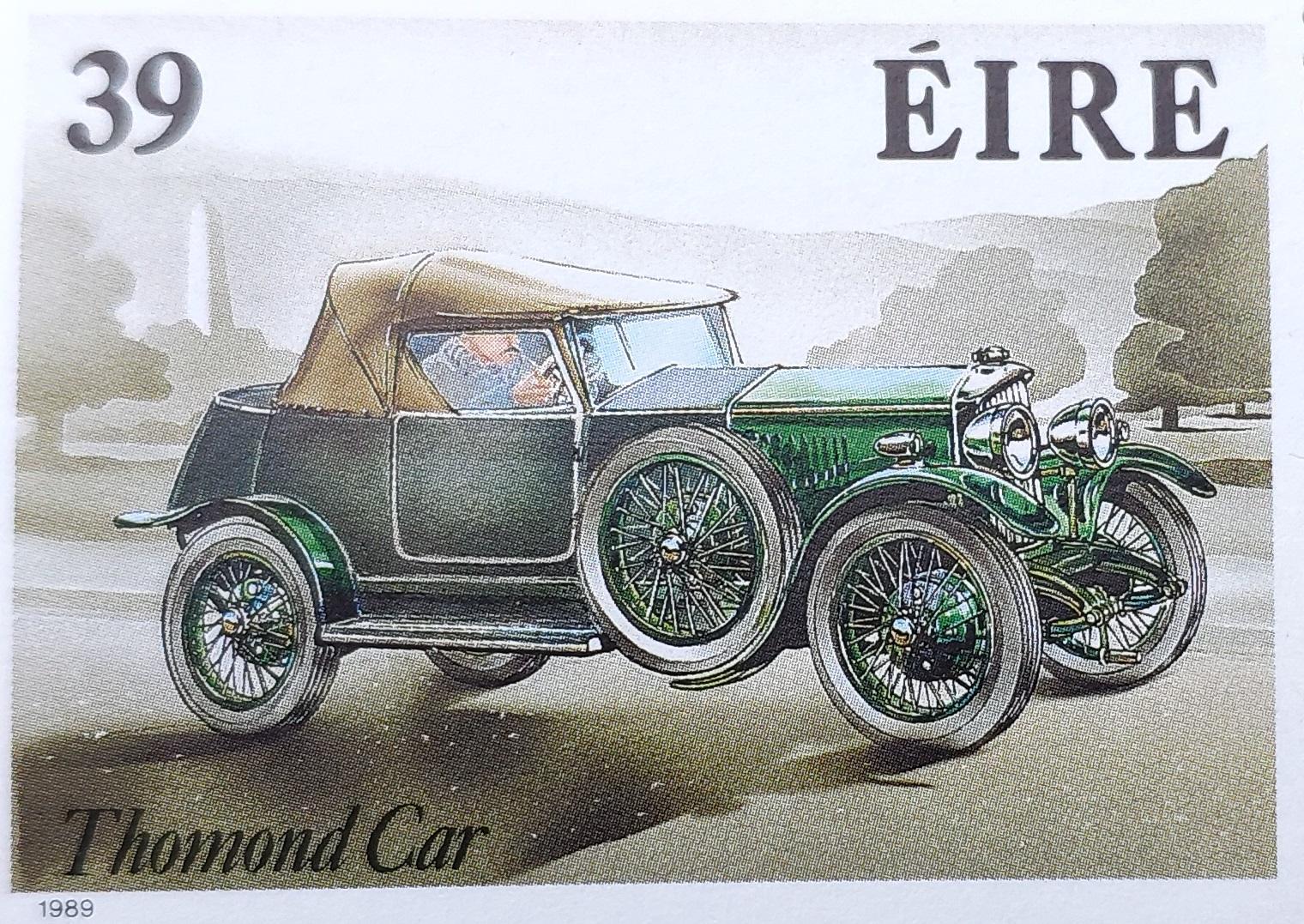
When featured on a
1989 stamp,
the Thomond was imagined
at the Phoenix Park.
Note the
Wellington Monument.
Apparently this was just luck,
rather than a
reference to Dick's article saying he reached his maximum speed there.
History, 1929-1933
Thomond no.2 was
built in 1929,
when Dick
was unmarried and living
in the family home on
Ailesbury Road.
In late 1929, he married and moved to
Sandymount
with his wife.
He used the Thomond as his regular
car for 4 years (1929-1933).
He drove 74,000 miles.
This was a huge mileage in those days.
He was still living at Sandymount when he scrapped/rebuilt Thomond no.2 in 1933.
Dick was never content with one design, and continually carried out
modifications and sketched on photographs of his car. His visible modifications
on this car were, in order:
- Removal of 'Spirit of Triumph' mascot.
- Movement of spare wheel from side to rear of car.
- Conversion of windscreen to enable it to be laid flat.
- Addition of windscreen wiper.
- 'Filling in' of dips in side of screen.
- Movement of Thomond logo from side of radiator (at angle) to front centre.
- Removal of original front number plate and replacement lower down.
Photos of Thomond no.2
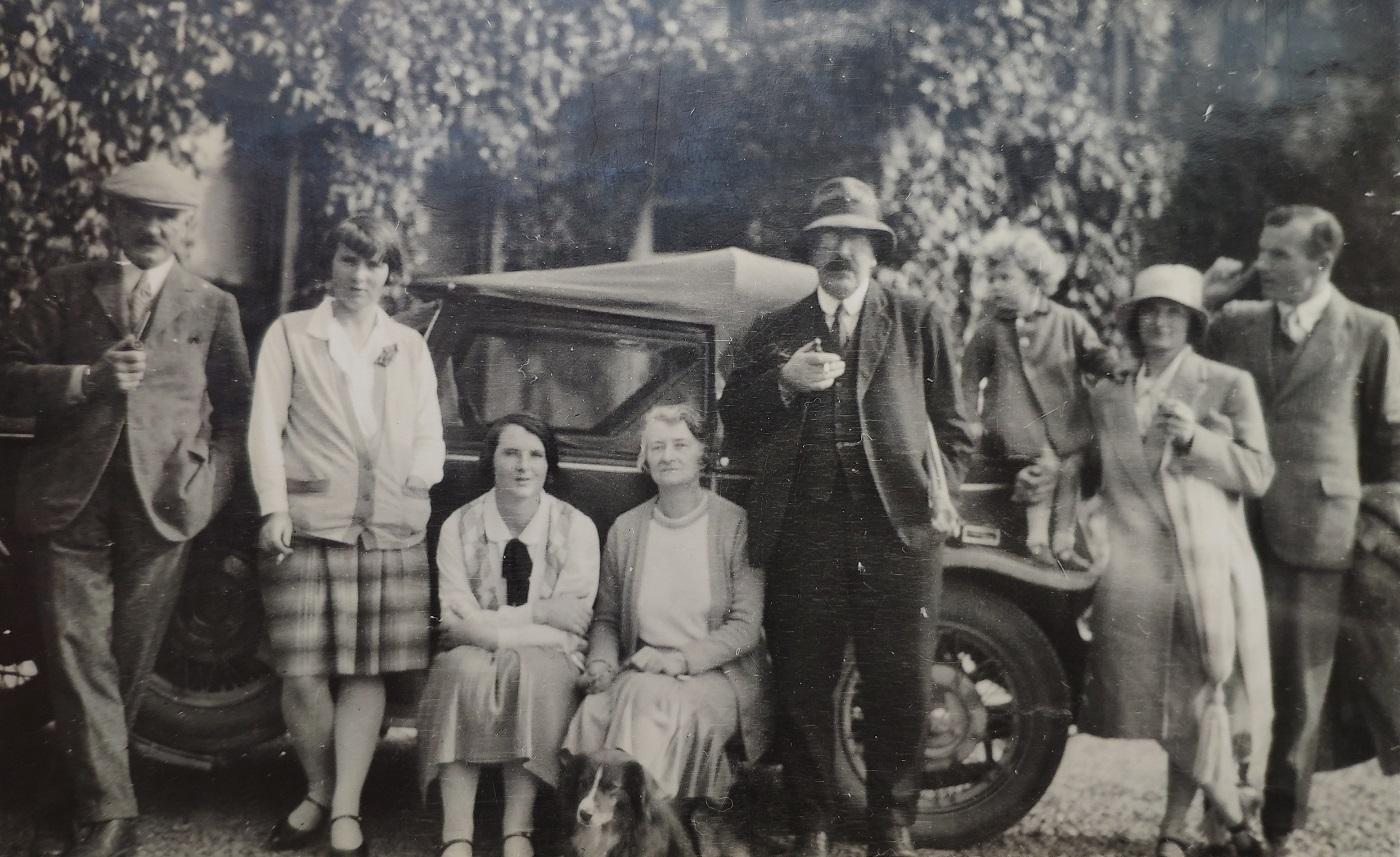
Thomond no.2
at
Cashel House.
Left to right:
Billy MacDonald (a friend),
Sheila O'Mara,
Eithne O'Mara,
Cousin Bee,
James O'Mara,
Ruaire Lavelle (born Nov 1924),
Pat Lavelle,
Steen O'Mara.
See
larger
and
full size.
Someone wrote "1928" on back of photo, and that looks right by
Ruaire's age.
But
Dick
says car finished 1929.
Photo must be summer 1929.
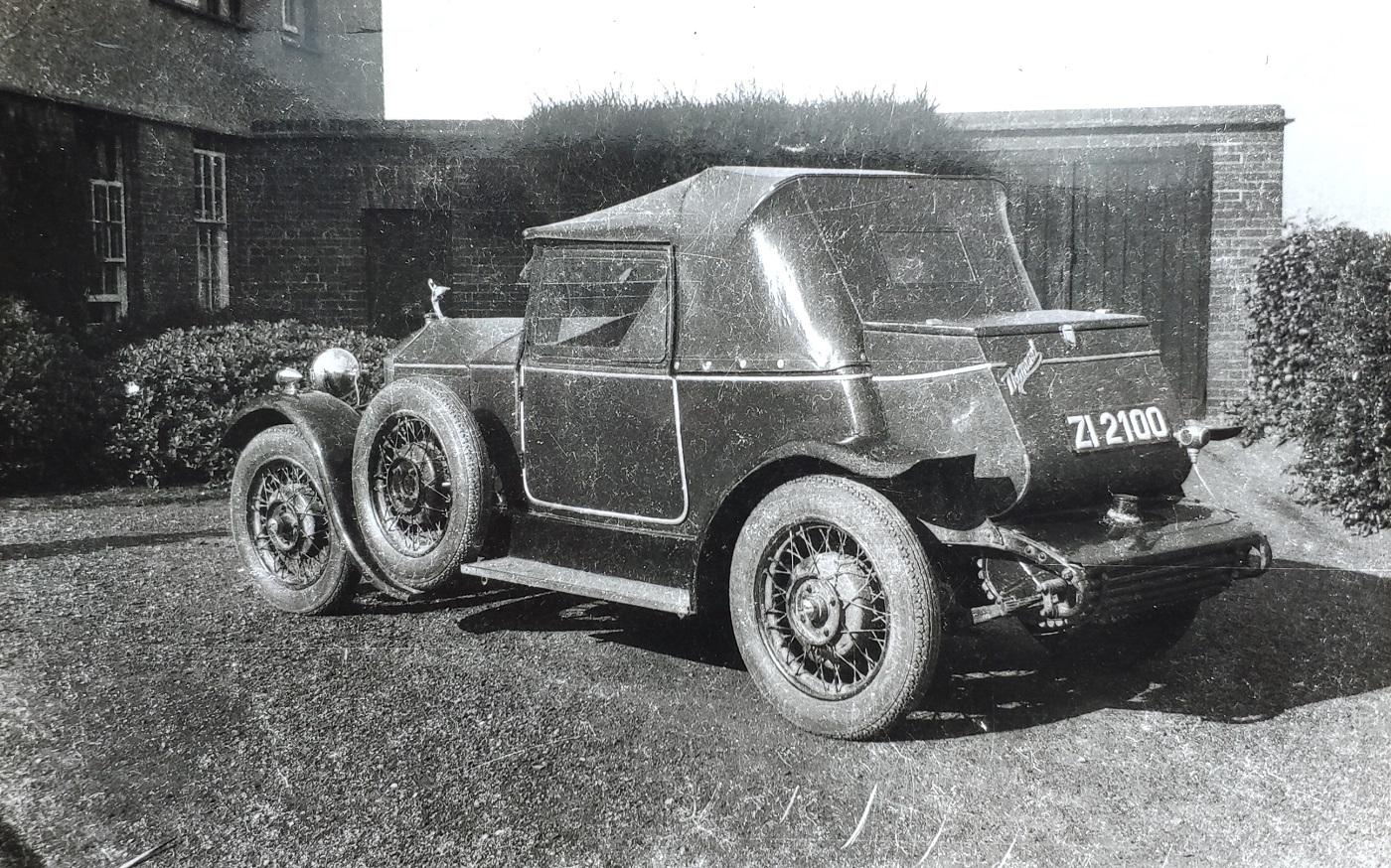
Thomond no.2 before modifications, at
36 Ailesbury Rd.
See larger
and full size.
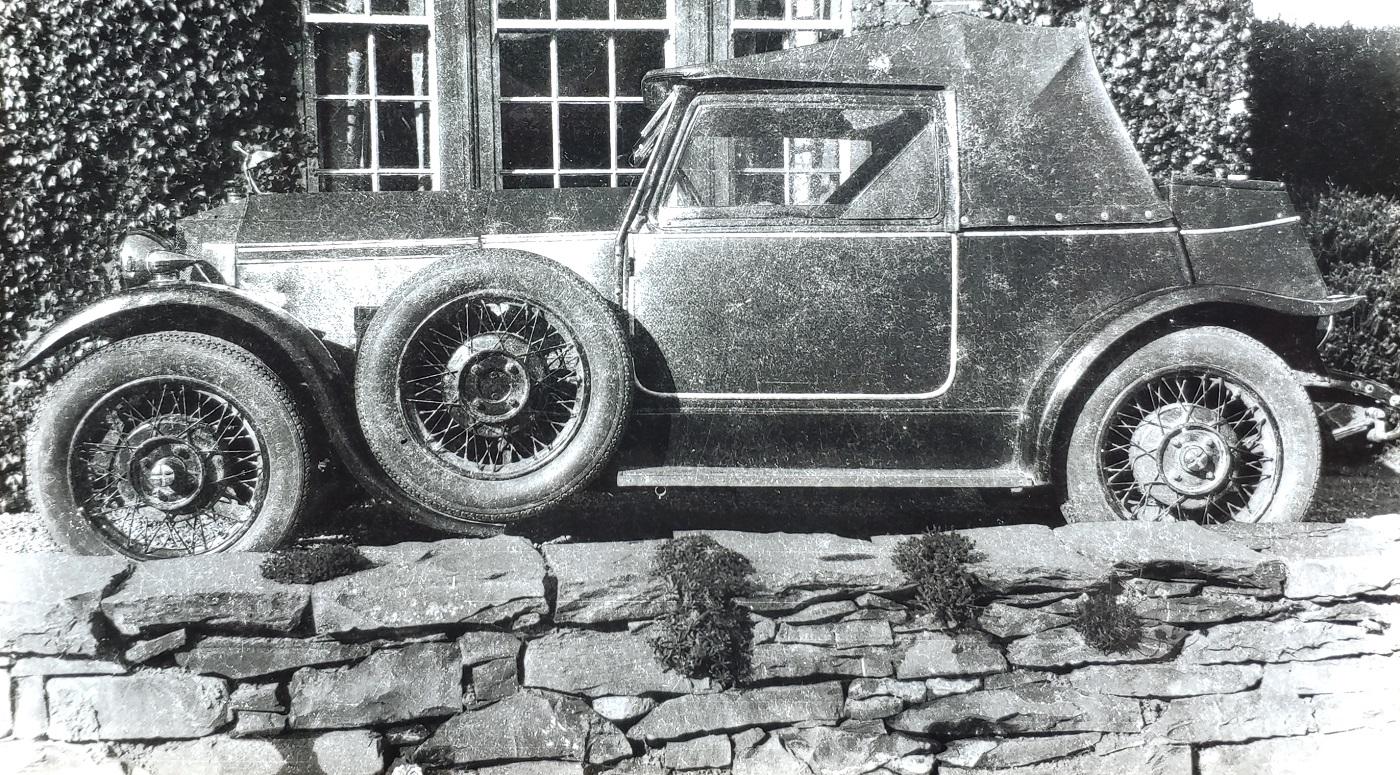
Thomond no.2 before modifications, at the front of 36 Ailesbury Rd.
See larger
and full size.
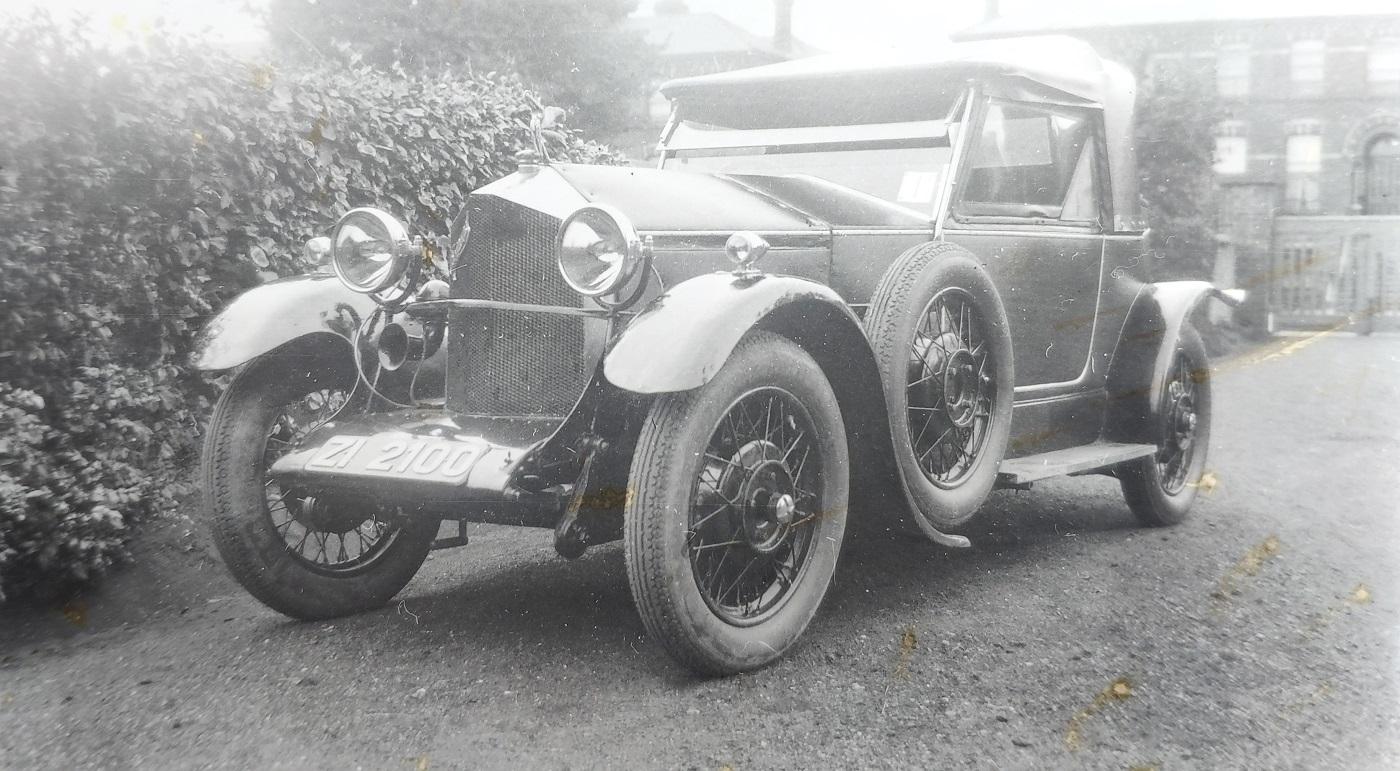
Thomond no.2 at 36 Ailesbury Rd.
See larger
and full size.
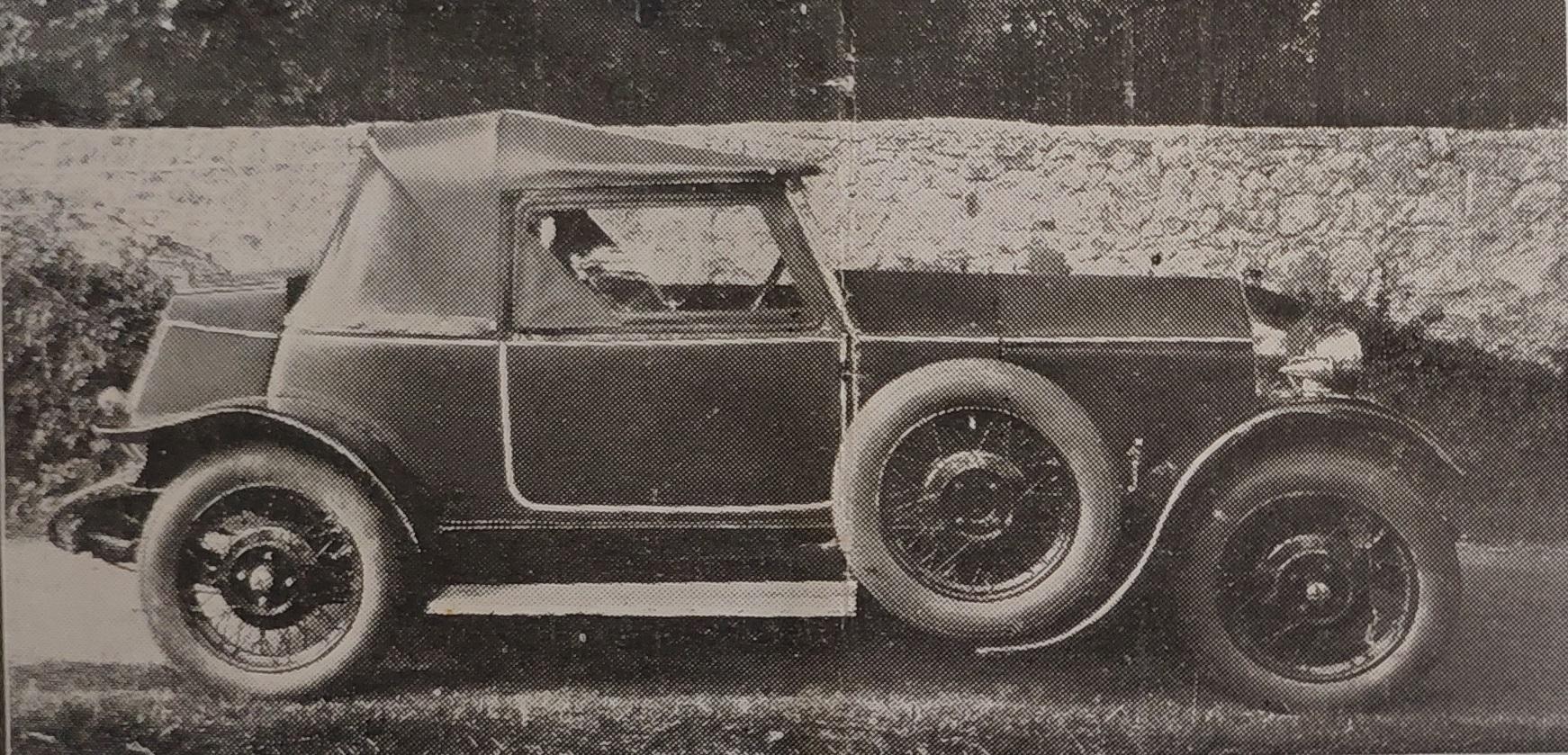
Thomond no.2 on the letterhead of Jones' garage.
Would be c.1930
(removal of the mascot being the only modification so far).
See larger
and full size.
See full page.
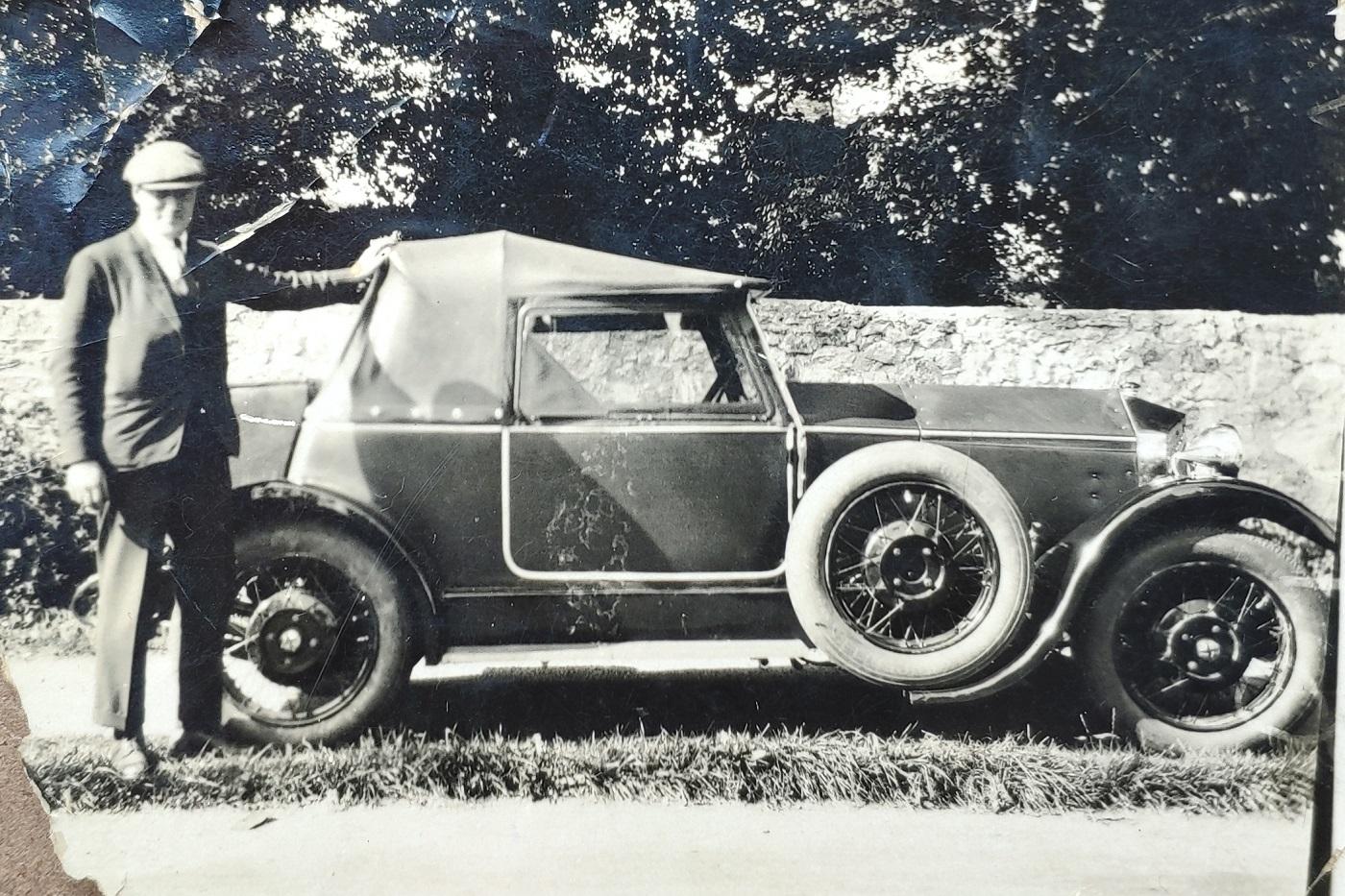
Photo on same day. Unidentified man.
See larger
and full size.
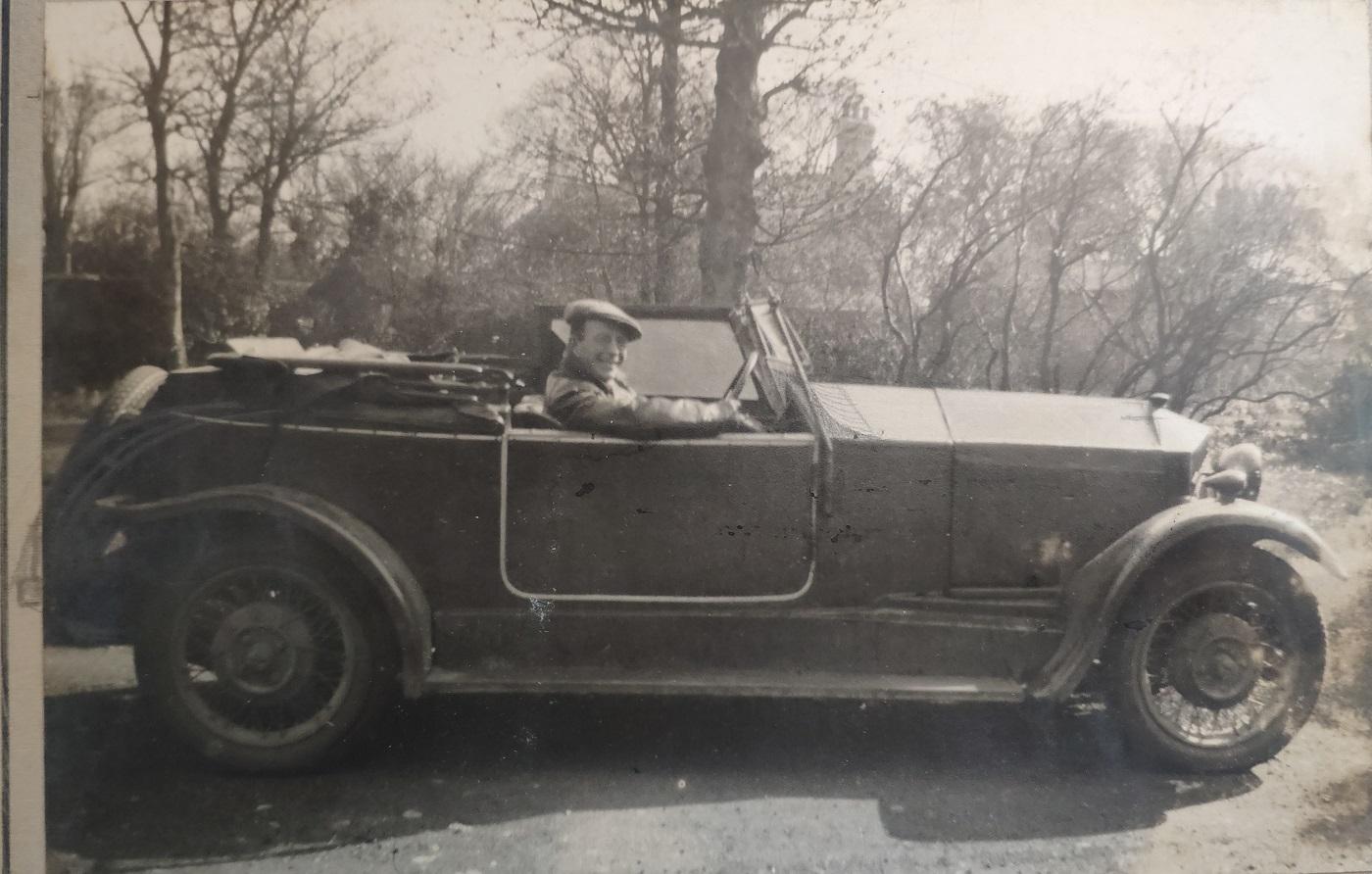
Dick in
Thomond no.2 at Sandymount.
He has moved the spare wheel from side to rear of car.
See larger
and full size.
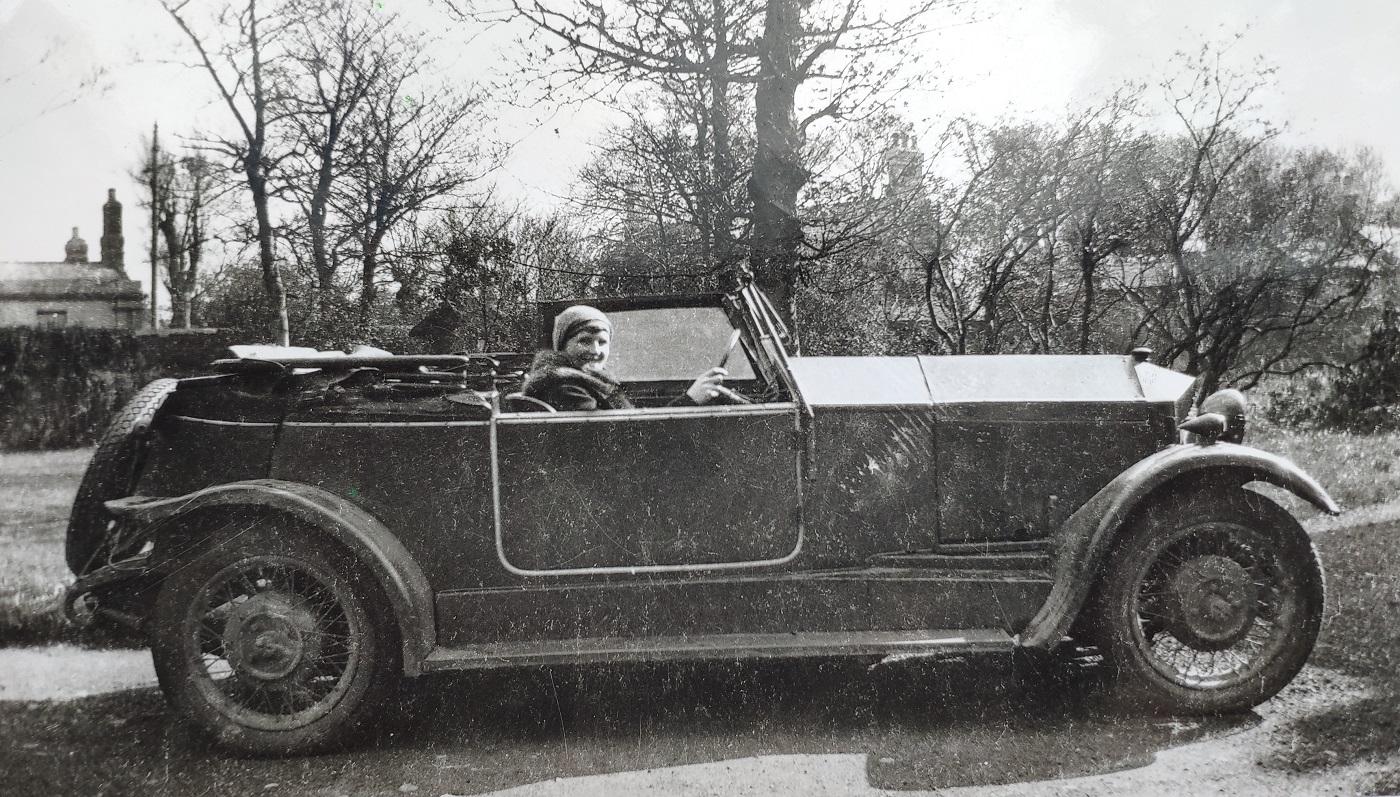
Eithne in
Thomond no.2 at Sandymount.
See larger
and full size.
See other copy.
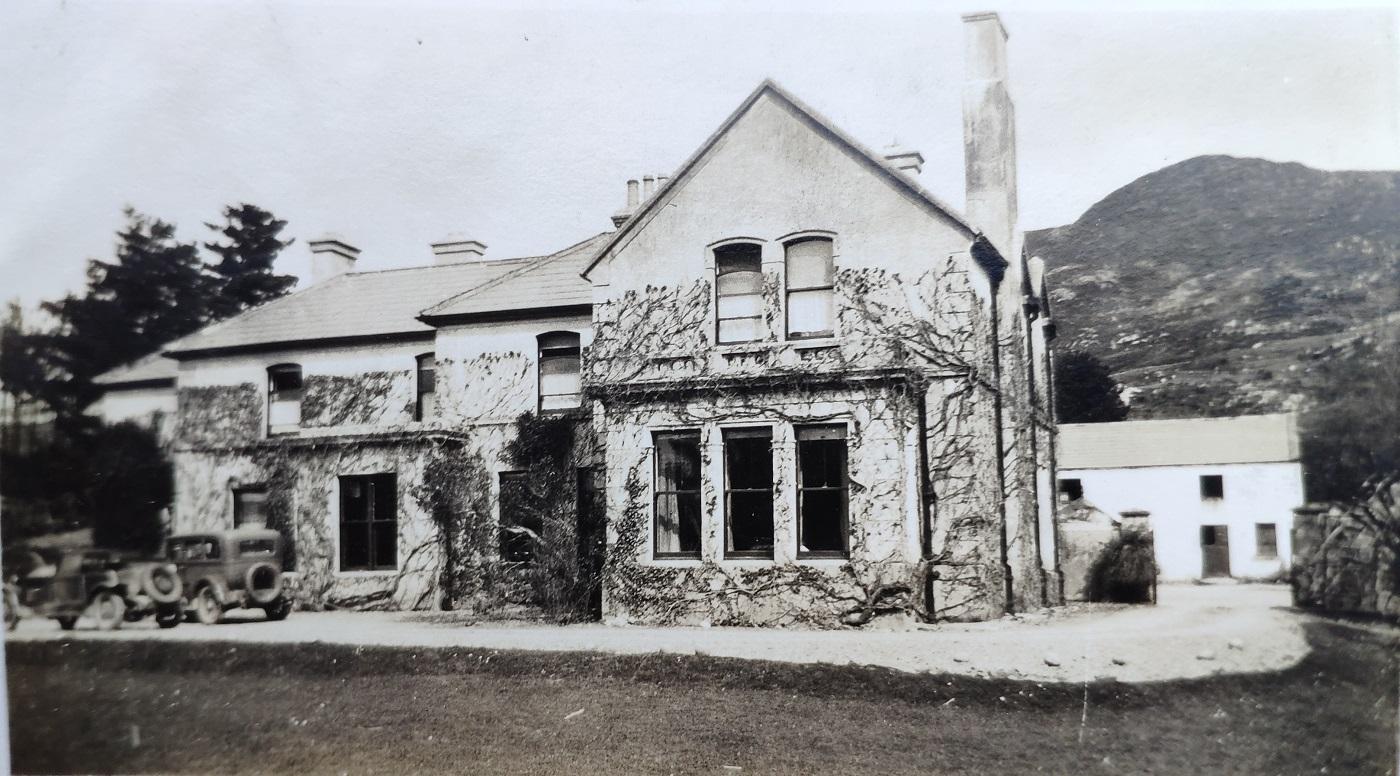
Thomond no.2 (on left, with spare wheel at rear).
Unknown saloon on right (possibly a
Model A Ford).
Cashel House.
Would be c.1930.
See larger
and full size.
See other scan.
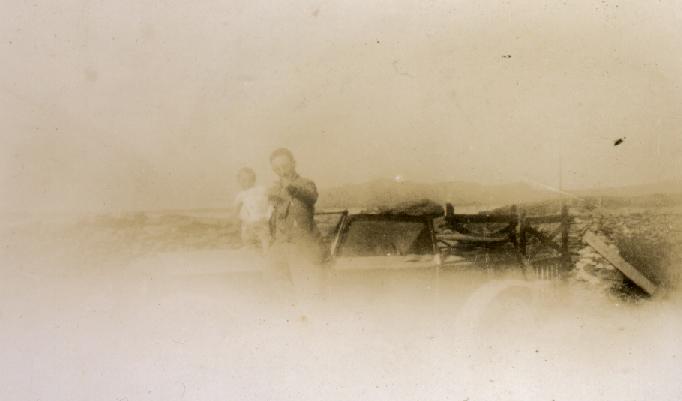
Thomond no.2, 1931.
Dick with
Eoige (born 1930).
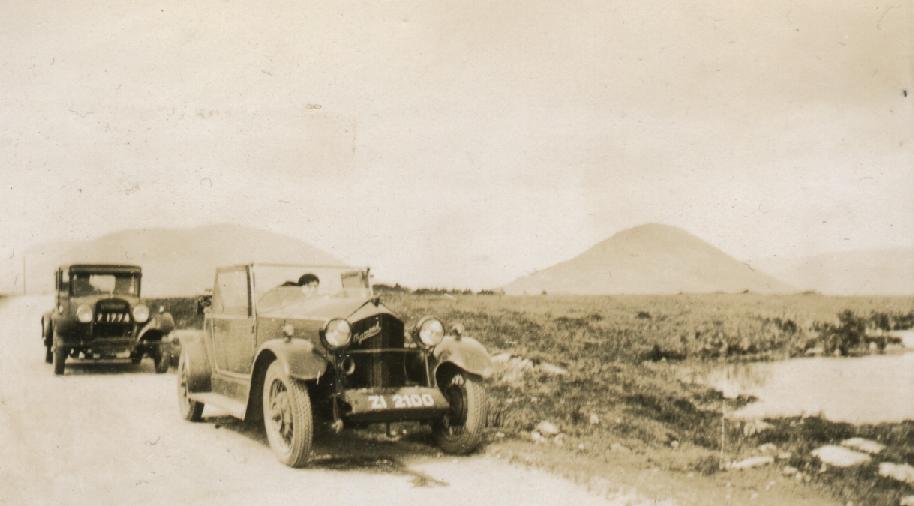
Thomond no.2, near Maam Cross, Connemara, 1931.
In the car is
Eithne.
Car in background belongs to James O'Mara.
It is a
Studebaker,
registration Z 1774.
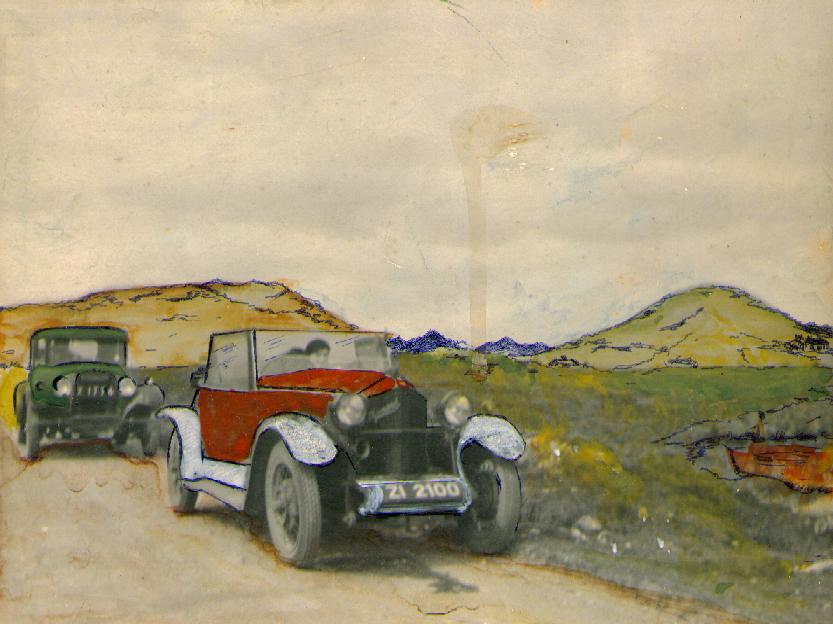
The above picture, painted over by Dick.
This confirms that his car was dark red.
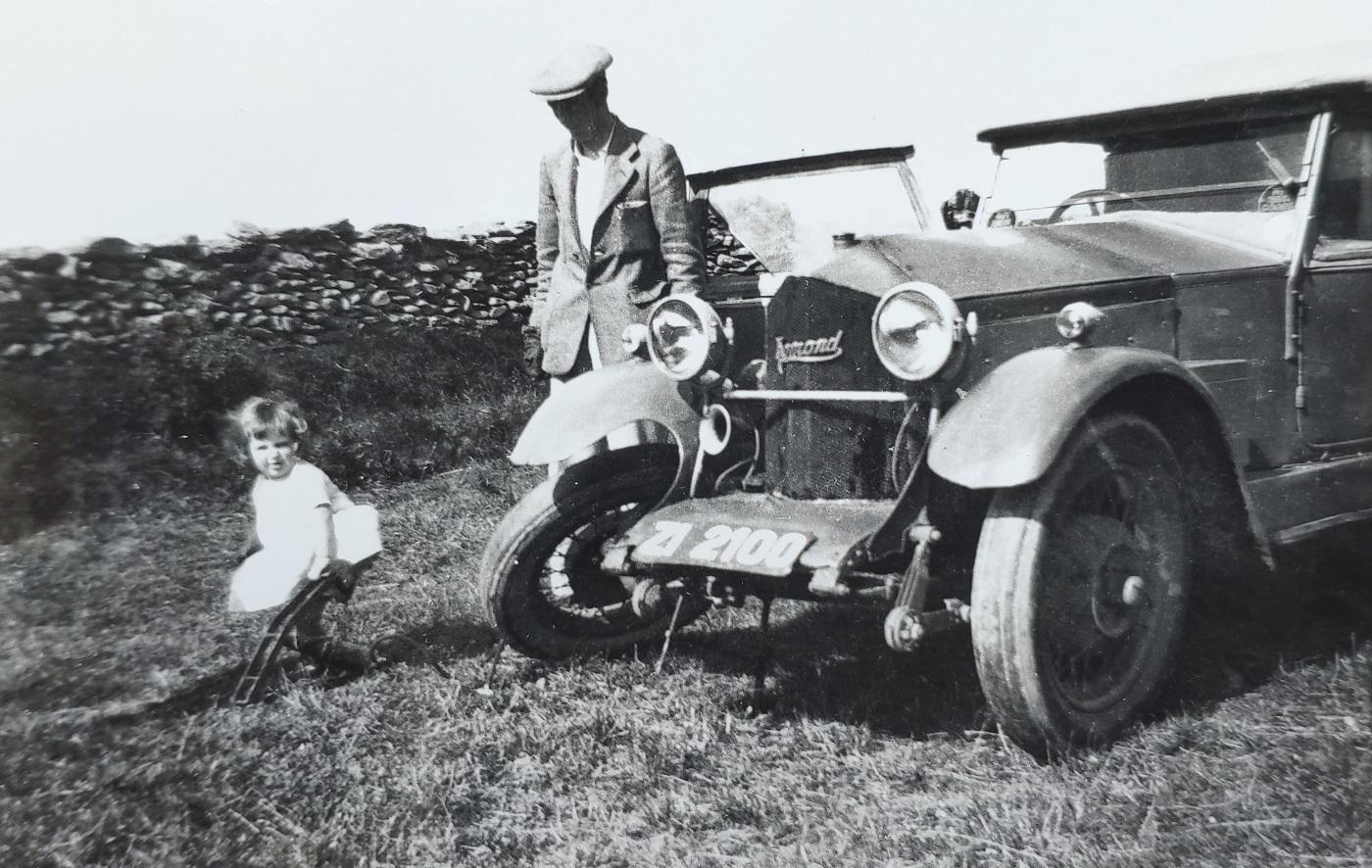
On holiday in Co.Kerry.
Dick with Eoige (born 1930).
Photo must be 1932-1933.
See larger
and full size.
Modifications that have been made:
- Conversion of windscreen to enable it to be laid flat.
- Addition of windscreen wiper.
- 'Filling in' of dips in side of screen.
- Movement of Thomond logo from side of radiator (at angle) to front centre.
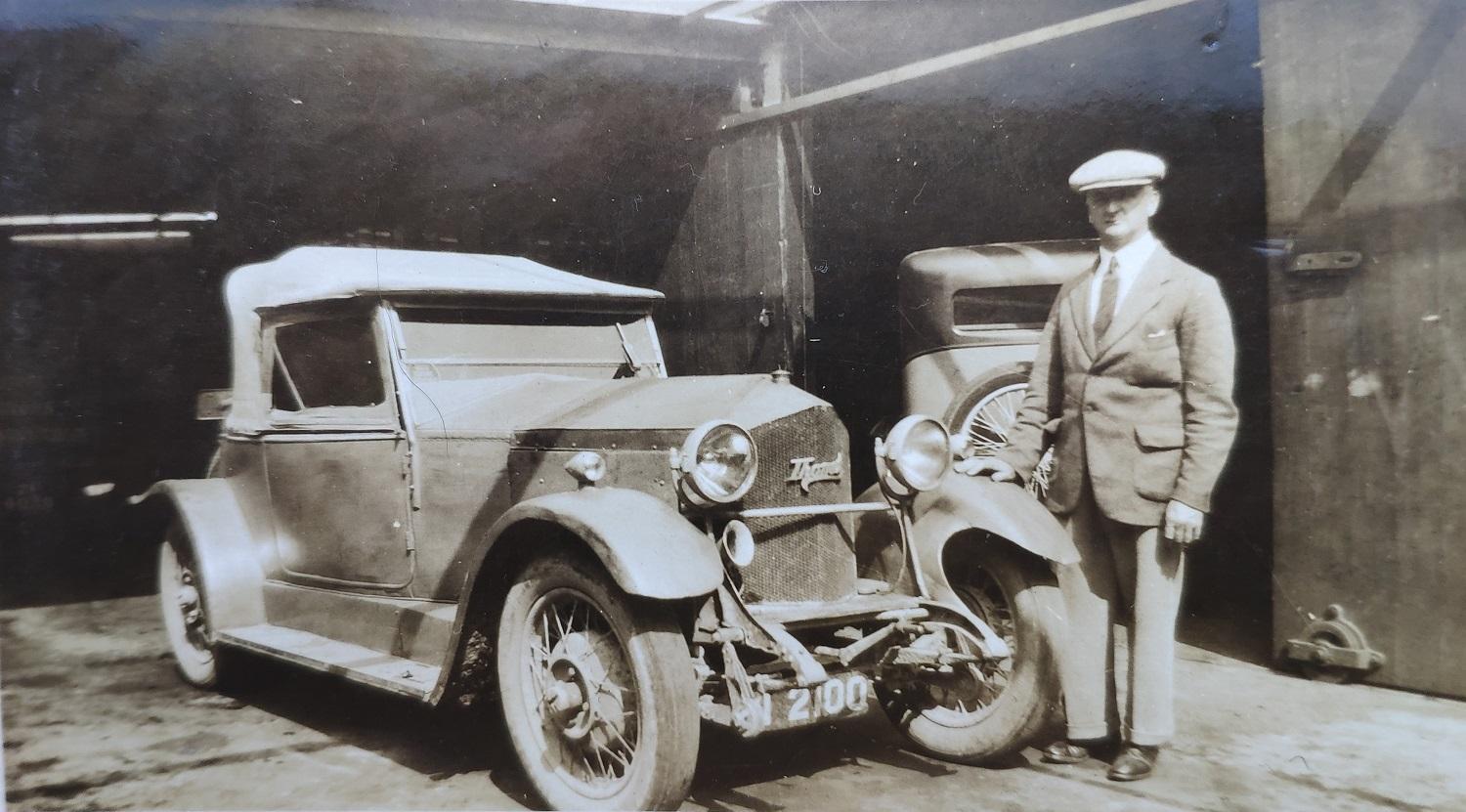
Thomond no.2, the final result, probably 1932-1933.
See
larger
and
full size.
See
other copy.
See
other scan.
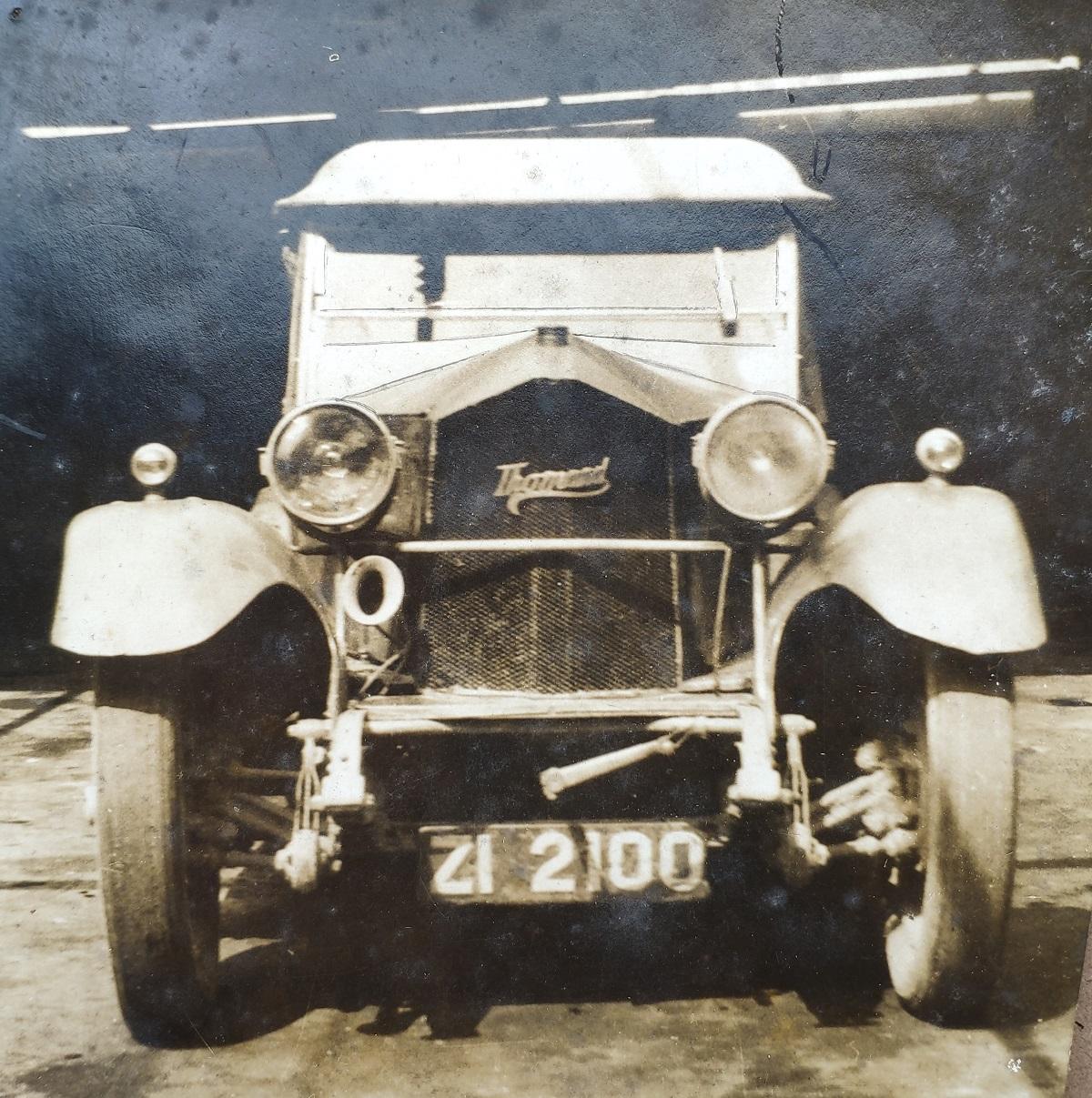
Another photo at Haddington Road.
See
larger
and
full size.
Dick scraps Thomond no.2 and rebuilds it, 1933
Thomond no.2 is officially listed as scrapped in 1933.
But it seems what actually happens is there was some damage to it,
and it was totally re-built as a new Thomond,
Thomond no.4.
Tommy McNamara,
who worked on the saloon car, Thomond no.3, in 1930,
remembers discussions of building a 'sports car' afterwards.
Dick may have been thinking about doing a major job on his Thomond at this early stage,
but he doesn't seem to have done anything about it until a couple of years later
when circumstances forced him to.
It appears that Dick had a crash or major incident in his Thomond in 1932/1933:
- Mac O'Rahilly,
Dick's 1st cousin, remembered Dick crashing his Thomond
during the winter of 1932/1933.
- Mac's brother
Aodogán O'Rahilly
remembered Dick in the Thomond
racing a Chrysler
along what was then the Stillorgan Road.
The Thomond drive shaft broke at the gearbox.
Dick let go of the wheel and got under the dashboard before impact.
Aodogán said it was an incredibly dangerous accident.
But, as far as we know, Dick was not badly hurt.
- Tommy O'Brien
said he never heard of a crash around this time.
Surprising that he didn't hear about it.
He said Dick was never without a car anyway.
In any case, Thomond no.2 was scrapped.
[Motor Reg]
records say that Thomond no.2 (registration number ZI 2100)
was officially scrapped
on 17 Feb 1933.
(An
abstract
of the record says 12 Feb in error.
The record itself says 17 Feb.)
But then, from at least as early as around Easter 1933,
a much different-looking Thomond
appears in the Humphreys family photographs. The bodywork is different,
and there is a new number plate, but underneath you can still see
that much of the old machine remains.
So it seems that what happened was
Thomond no.2 was scrapped
and re-built as a new Thomond, with a new registration number,
Thomond no.4.
Aodogán O'Rahilly,
Dick's 1st cousin, remembered Dick having two Thomonds - one after the other.

Dick writes about the end of the car in
1963 article.
He refers to the propellor shaft breaking, but he does not blame it on racing and he does not mention a crash.
He
says the Thomond gave him
"four of the happiest motoring years in a lifetime".
Four years is significant.
It means he regarded Thomond no.2 as existing from 1929 to 1933.
But then what is that Thomond found in
later pictures?
He obviously regards that as a separate car.
See
full article.





























